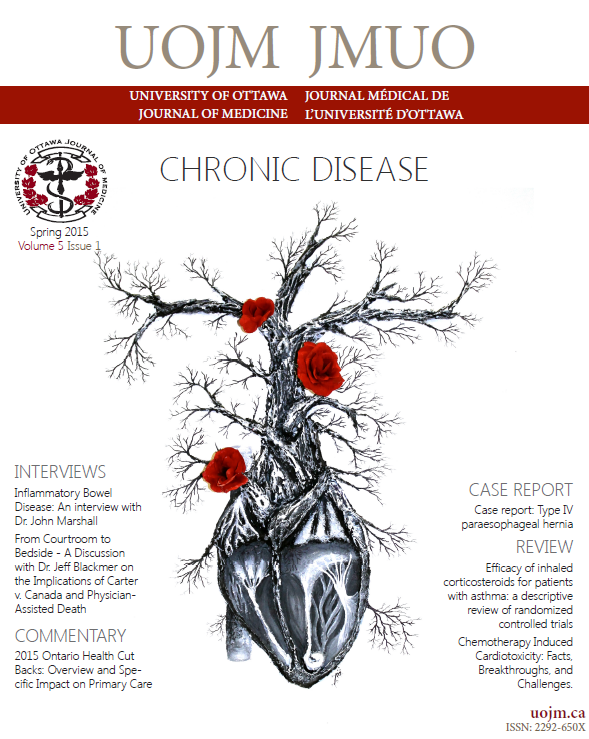Improving Chronic Kidney Disease Management using Wagner’s Model for Chronic Care
DOI :
https://doi.org/10.18192/uojm.v5i1.1213Résumé
The incidence of chronic disease is increasing as the population ages. Consequently, the Canadian health care system needs to implement systemic changes to manage chronic disease effectively. This paper applies the six basic elements for improving chronic care found in Wagner’s Chronic Care Model (CCM) to the management of chronic kidney disease. A fictional patient, Paul, is used to demonstrate the usefulness of this model in managing chronic diseases at a systemic and individual level.
Références
1. Klostranec, JM, Kolin, DL, editors. Toronto Notes: A comprehensive medical reference & review for MCCQE I & USMLE II. 28th ed. Toronto, ON: Type & Graphics Inc; 2012. NP21-23 p.
2. Stevens, P. Models of Chronic Kidney Disease Care and Initiation of Dialysis. Presented at: Kent Kidney Care Centre, East Kent Hospitals, UK. PowerPoint presentation available from: http://www.kdigo.org/meetings_events/pdf/novel_tech/Paul%20Stevens.pdf
3. Barr, VJ, Robinson, S, Marin-Link, B, Underhill, L, Dotts, A, Ravensdale, D, et al. The Expanded Chronic Care Model: An Integration of Concepts and Strategies from Population Health Promotion and the Chronic Care Model. Hospital Quarterly 2003;7(1):73-83. http://dx.doi.org/10.12927/hcq.2003.16763
4. The Chronic Care Model [Internet]. Seattle: Improving Chronic Illness Care; c2006-2014 [cited 2014 May 11]. Available from: http://www.improvingchroniccare.org/index.php?p=The_Chronic_Care_Model&s=2
5. Improving Chronic Illness Care. Does the Chronic Care Model Work? Presented at: Group Health’s MacColl Institute. PowerPoint presentation available from: http://www.improvingchroniccare.org/downloads/2007_chronic_care_model.ppt
6. Narva, A, Briggs, M. The National Kidney Disease Education Program: improving understanding, detection, and management of CKD. American Journal of Kidney Diseases. 2009; 53(3) Supplement 3: S115-S120.
7. Ostbye, T, Yamall, KS, Krause, KM, Pollak, KI, Gradison, M, Michener, JL. Is there time for management of patients with chronic diseases in primary care? Ann Fam Med. 2005 May;3(3):209-214.
8. Poulos, RK, Antonsen, JE. Optimizing chronic kidney disease care: The primary-specialty care interface. BC Medical Journal 2005;47(6):300-304.
9. Levitt, C, Hilts, L. Quality Book of Tools. Hamilton: McMaster Innovation Press; 2010.
10. Victorian Government Department of Health. Promoting effective communication among healthcare professionals to improve patient safety and quality of care. Melbourne: Victorian Quality Council; 2010.
11. Renal PatientView [Internet]. NHS. [cited 2014 May 11]. Available from: https://www.patientview.org/index.do
2. Stevens, P. Models of Chronic Kidney Disease Care and Initiation of Dialysis. Presented at: Kent Kidney Care Centre, East Kent Hospitals, UK. PowerPoint presentation available from: http://www.kdigo.org/meetings_events/pdf/novel_tech/Paul%20Stevens.pdf
3. Barr, VJ, Robinson, S, Marin-Link, B, Underhill, L, Dotts, A, Ravensdale, D, et al. The Expanded Chronic Care Model: An Integration of Concepts and Strategies from Population Health Promotion and the Chronic Care Model. Hospital Quarterly 2003;7(1):73-83. http://dx.doi.org/10.12927/hcq.2003.16763
4. The Chronic Care Model [Internet]. Seattle: Improving Chronic Illness Care; c2006-2014 [cited 2014 May 11]. Available from: http://www.improvingchroniccare.org/index.php?p=The_Chronic_Care_Model&s=2
5. Improving Chronic Illness Care. Does the Chronic Care Model Work? Presented at: Group Health’s MacColl Institute. PowerPoint presentation available from: http://www.improvingchroniccare.org/downloads/2007_chronic_care_model.ppt
6. Narva, A, Briggs, M. The National Kidney Disease Education Program: improving understanding, detection, and management of CKD. American Journal of Kidney Diseases. 2009; 53(3) Supplement 3: S115-S120.
7. Ostbye, T, Yamall, KS, Krause, KM, Pollak, KI, Gradison, M, Michener, JL. Is there time for management of patients with chronic diseases in primary care? Ann Fam Med. 2005 May;3(3):209-214.
8. Poulos, RK, Antonsen, JE. Optimizing chronic kidney disease care: The primary-specialty care interface. BC Medical Journal 2005;47(6):300-304.
9. Levitt, C, Hilts, L. Quality Book of Tools. Hamilton: McMaster Innovation Press; 2010.
10. Victorian Government Department of Health. Promoting effective communication among healthcare professionals to improve patient safety and quality of care. Melbourne: Victorian Quality Council; 2010.
11. Renal PatientView [Internet]. NHS. [cited 2014 May 11]. Available from: https://www.patientview.org/index.do
Téléchargements
Publié-e
2015-05-22
Numéro
Rubrique
Commentary
Licence
- Les auteurs qui publient dans le JMUO gardent les droits d’auteur de leurs articles, incluant tous les brouillons et la copie finale publiée dans le journal
- Bien que le JMUO n’a pas les droits d’auteur des articles soumis, en acceptant de publier dans le JMUO, les auteurs donnent le droit au journal d’être les premiers à publier et à distribuer leurs articles.
- Par la suite, les auteurs peuvent soumettre leurs documents à d’autres publications, incluant des revues ou des livres, avec un remerciement de leur première publication dans le JMUO
- Des copies du JMUO seront distribuées à la fois sous format papier et en ligne, et tous les matériaux seront accessibles au public en ligne. Le journal n’a pas de responsabilité légale par rapport à la distribution publique du contenu.
- Prière de vous assurer que tous les auteurs, les coauteurs et les investigateurs
- Le contenu est rendu disponible sous licence Creative Commons Attribution - Pas d'Utilisation Commerciale - Pas de Modification 4.0 International.


